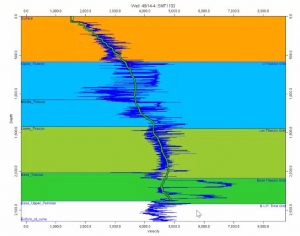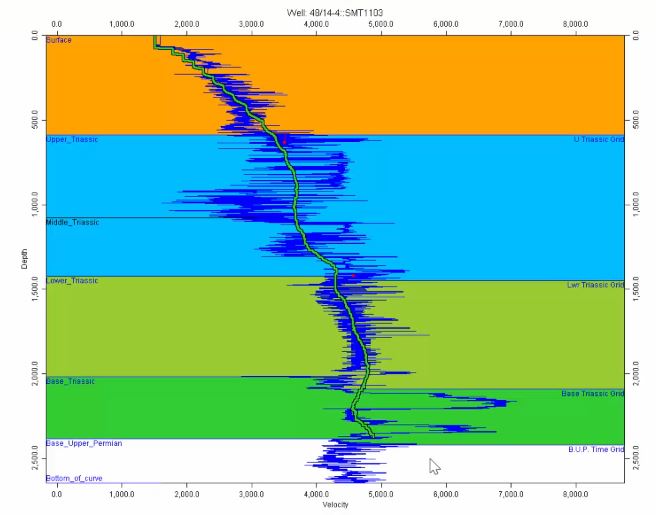VelPAK’s Velocity module uses stacking velocities to create pseudo wells by amalgamating velocities in a definable radius and then scaling the stacking velocities to the wells, per layer. The additional data generated provides control away from your wells, giving you confidence in your depth uncertainty, especially with only sparse data available.
The amalgamation process creates a combined time depth curve (pseudo-well) from surrounding time depth curves generated via the Dix process. This works by gathering data within a search radius. Pseudo-wells at the same location as a true well can be generated and the results compared.
VelPAK generates a cylinder, with a radius of the search distance based on the value of the mute distance (fixed from Dix) at the midpoint. The top and base of the cylinder are the time grids for the top and base of the layer. Only data points from within this cylinder are considered.
These ‘cylinders’ are then added together and rearranged to form a pseudo-sonic log by calculating an interval velocity between each sample down each stacking velocity analysis curve, and a midpoint depth for each of these sample pairs and then sorting these midpoint depths into order re-integrating to get a time-depth curve.
 The generated curve is then in the same form as all the other VelPAK sonic logs, which are stored as time-depth curves.
The generated curve is then in the same form as all the other VelPAK sonic logs, which are stored as time-depth curves.
It can be particularly interesting to generate a pseudo-well at the same location as a true well and compare results. Alternatively, a coarse grid of pseudo-wells can be generated automatically or from the survey locations. This is a powerful technique to smooth the errors in the stacking velocity data whilst maintaining information. Once the grid of pseudo-wells is complete the Curve module can be used to generate a set of control points of interval velocity for gridding.
The pseudo-wells generated by this process are identical to real wells as far as the rest of the program is concerned. The pseudo-wells can therefore be used in the Optimize module to fit functions to them, as well as obtaining interval velocity maps etc. The time-depth curve for each pseudo-well is defined for all layers defined in the current model.
Watch the short video on Pseudo Wells below.
VelPAK’s Velocity module uses stacking velocities to create pseudo wells by amalgamating velocities in a definable radius and then scaling the stacking velocities to the wells, per layer. The additional data generated provides control away from your wells, giving you confidence in your depth uncertainty, especially with only sparse data available.

